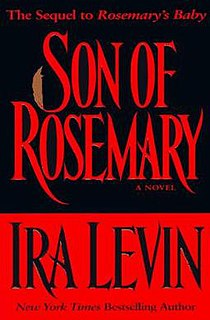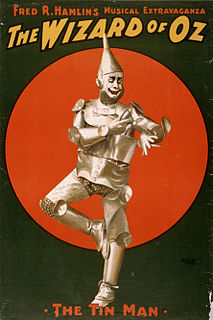
Vanilla Sky is a 2001 American science fiction psychological thriller film directed, written, and co-produced by Cameron Crowe. It is an English-language adaptation of Alejandro Amenábar's 1997 Spanish film Open Your Eyes, which was written by Amenábar and Mateo Gil, with Penélope Cruz reprising her role from the original film. The film has been described as "an odd mixture of science fiction, romance and reality warp".
A story within a story is a literary device in which one character within a narrative narrates. Mise en abyme is the French term for a similar literary device. A story within a story can be used in all types of narration: novels, short stories, plays, television programs, films, poems, songs, and philosophical essays. The inner stories are told either simply to entertain or more usually to act as an example to the other characters. In either case the story often has symbolic and psychological significance for the characters in the outer story. There is often some parallel between the two stories, and the fiction of the inner story is used to reveal the truth in the outer story. Often the stories within a story are used to satirize views, not only in the outer story, but also in the real world. When a story is told within another instead of being told as part of the plot, it allows the author to play on the reader's perceptions of the characters—the motives and the reliability of the storyteller are automatically in question. Stories within a story may disclose the background of characters or events, tell of myths and legends that influence the plot, or even seem to be extraneous diversions from the plot. In some cases, the story within a story is involved in the action of the plot of the outer story. In others, the inner story is independent, so that it can either be skipped over or be read separately, although many subtle connections may be lost. Sometimes, the inner story serves as an outlet for discarded ideas that the author deemed to be of too much merit to leave out completely, something that is somewhat analogous to the inclusion of deleted scenes with DVD releases of films. Often, there is more than one level of internal stories, leading to deeply-nested fiction.
Seventeen or 17 may refer to:

James and the Giant Peach is a 1996 British-American musical fantasy film directed by Henry Selick, based on the 1961 novel of the same name by Roald Dahl. It was produced by Tim Burton and Denise Di Novi, and starred Paul Terry as James. The film is a combination of live action and stop-motion animation. Co-stars Joanna Lumley and Miriam Margolyes played James's aunts in the live-action segments, and Simon Callow, Richard Dreyfuss, Susan Sarandon, Jane Leeves, David Thewlis, and Margolyes voiced his insect friends in the animation sequences.

Lloyd Francis Bacon was an American screen, stage and vaudeville actor and film director. As a director he made films in virtually all genres, including westerns, musicals, comedies, gangster films, and crime dramas. He was one of the directors at Warner Bros. in the 1930s who helped give that studio its reputation for gritty, fast-paced "torn from the headlines" action films. And, in directing Warner Bros.' 42nd Street, he joined the movie's song-and-dance-number director, Busby Berkeley, in contributing to "an instant and enduring classic [that] transformed the musical genre."
Wild, wild or wild may refer to:

A Connecticut Yankee is a musical based on the novel A Connecticut Yankee in King Arthur's Court by American writer Mark Twain. Like most adaptations of the Twain novel, it focuses on the lighter aspects of the story. The music was written by Richard Rodgers, the lyrics by Lorenz Hart, and the book by Herbert Fields. It was produced by Lew Fields and Lyle D. Andrews. It enjoyed an original run on Broadway in 1927 of 421 performances and a number of revivals.

High School Musical is a 2006 American musical television film written by Peter Barsocchini and directed by Kenny Ortega. It is the first installment in the High School Musical trilogy.

Dreamgirls is a 2006 American romantic musical drama film written and directed by Bill Condon and jointly produced and released by DreamWorks Pictures and Paramount Pictures. Adapted from the 1981 Broadway musical of the same name by composer Henry Krieger and lyricist/librettist Tom Eyen, Dreamgirls is a film à clef, a work of fiction taking strong inspiration from the history of the Motown record label and one of its acts, The Supremes. The story follows the history and evolution of American R&B music during the 1960s and 1970s through the eyes of a Detroit, Michigan girl group known as the Dreams and their manipulative record executive.

The American Airlines Theatre, originally the Selwyn Theatre, is a historic Italian Renaissance style Broadway theatre in New York City built in 1918. It was designed by George Keister and built by the Selwyn brothers. Used for musicals and other dramatic performances it was eventually converted for film. It was used briefly as a visitor's center but stood vacant for years until a 1997 renovation and restoration. It is located at 227 West 42nd Street.
John Skipp is a splatterpunk horror and fantasy author and anthology editor, as well as a songwriter, screenwriter, film director, and film producer. He collaborated with Craig Spector on multiple novels, and has also collaborated with Marc Levinthal and Cody Goodfellow. He worked as editor-in-chief of both Fungasm Press and Ravenous Shadows.

The Old Man and the Sea is a 1999 paint-on-glass-animated short film directed by Russian animator Aleksandr Petrov, based on the novel of the same name by Ernest Hemingway. The film won many awards, including the Academy Award for Best Animated Short Film.

Son of Rosemary is a 1997 horror novel by American writer Ira Levin. It is the sequel to Rosemary's Baby.
Dream worlds are a commonly used plot device in fictional works, most notably in science fiction and fantasy fiction. The use of a dream world creates a situation whereby a character is placed in a marvellous and unpredictable environment and must overcome several personal problems to leave it. The dream world also commonly serves to teach some moral or religious lessons to the character experiencing it – a lesson that the other characters will be unaware of, but one that will influence decisions made regarding them. When the character is reintroduced into the real world, the question arises as to what exactly constitutes reality due to the vivid recollection and experiences of the dream world.

The Wonderful Wizard of Oz is a 1900 children's novel written by American author L. Frank Baum. Since its first publication in 1900, it has been adapted many times: for film, television, theatre, books, comics, games, and other media.
Alice Through the Looking Glass is a 1987 Australian-Italian animated film nominally based on the novel Through the Looking-Glass by Lewis Carroll. It was directed by Andrea Bresciani and Richard Slapczynski from a screenplay by Jameson Brewer. The movie starts off with a bored Alice trapped in her house by a snow storm. The film's voice cast includes Janet Waldo as Alice, Mr. T. as the Jabberwock, Phyllis Diller as the White Queen, Jonathan Winters as Tweedledum and Tweedledee, and Alan Young as the White Knight. Much of the film consists of Alice and a jester named Tom Fool magical trickery tragic castle tower red little ball wind tornado golden citizen wonderland journeying through some of the incidents of the novel, while ultimately, the film is more about Alice finding an imaginary friend in Tom Fool than the novel's themes of logic, illogic, and reversal. The film also throws in Heffalumps, rock-throwing cavemen, Ed Sullivan, The Marx Brothers and Humpty Dumpty. There is also a man made entirely out of newspaper, a talking horse and a talking goat. When Alice wakes up, her father plays a game of chess with her, which her dream journey was based on, walking from square to square on a large chessboard.
Three Blind Mouseketeers is a Silly Symphonies cartoon based on the nursery rhyme Three Blind Mice and the novel The Three Musketeers by Alexandre Dumas. Directed by Dave Hand and Jack Cutting, it stars Billy Bletcher.












